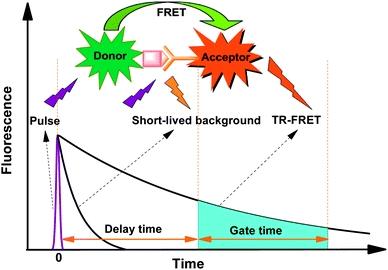When excited by an external energy source (e.g. lamp or laser), many biological compounds will immediately fluoresce. This autofluorescence complicates sensitive assays by adding background signal (noise), obscuring targeted results. A solution to reduce this noise is to use time-resolved fluorescence (TRF) measurement. TRF and TR-FRET assays use fluorophores with large Stokes shifts and long emission half-lives. This allows for a delay between excitation and emission detection, resulting in lower measurment backgrounds.
TRF and TR-FRET assays have found much success in drug screening applications which require robustness, assay automation and assay minaturization. Common TRF flurophores include:
See figure 1 below:

Figure 1. Mechanism for time-delayed FRET detection.
The fluorophores for these assays are designed to have long emission half-lives, and so their emission signal will be easily read, lasting longer than the sample fluorescence will and allowing sensitive detection with minimal interference. Improved fluorophores with higher stability and emission yield such as the tr-FluorTM series have aided in the popularity of this technique.
